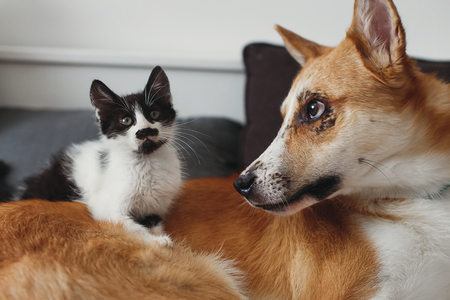1. Pet Insurance is Too Expensive
One of the most common myths about pet insurance in the US is that its simply too expensive for the average pet owner. While it’s true that some plans can have higher premiums, there are actually a wide range of options available that can fit almost any budget.
How Affordable is Pet Insurance?
The cost of pet insurance varies depending on factors like your pet’s age, breed, and where you live. But many providers offer flexible plans with different coverage levels to help you find something that works for you. Here’s a general idea of what you might pay:
| Coverage Level | Monthly Cost Range* | What’s Typically Included |
|---|---|---|
| Accident-Only | $10 – $20 | Covers injuries from accidents (broken bones, swallowed objects) |
| Accident & Illness | $25 – $50 | Covers accidents plus illnesses (infections, cancer, etc.) |
| Comprehensive/Wellness Add-ons | $40 – $70+ | Covers accidents, illnesses, plus routine care (vaccines, check-ups) |
*Actual costs depend on provider, location, and your pets details.
Ways to Make Pet Insurance Work for Your Budget
- Shop Around: Different companies offer different prices and discounts. Comparing quotes can save you money.
- Adjust Your Deductible: Higher deductibles usually mean lower monthly payments.
- Choose the Right Coverage: If you just want coverage for big emergencies, accident-only plans are more affordable.
- Take Advantage of Multi-Pet Discounts: Insuring more than one pet often comes with savings.
Did You Know?
Most American pet owners spend hundreds or even thousands of dollars a year on unexpected vet bills. Even basic insurance can help cover those surprise costs and make budgeting easier.
2. Pet Insurance Covers All Veterinary Expenses
One of the most common myths about pet insurance in the United States is that it covers every single vet bill, no matter what. In reality, pet insurance policies almost always have some limitations and exclusions. Understanding what is typically covered—and what isn’t—can help you choose the right plan for your furry friend and avoid surprises when you need to file a claim.
What’s Usually Covered by Pet Insurance?
Most American pet insurance plans are designed to help with unexpected accidents and illnesses. Here’s a quick look at what you can generally expect:
| Typically Covered | Usually Not Covered |
|---|---|
| Accidents (broken bones, cuts, swallowed objects) | Pre-existing conditions (illnesses or injuries before policy starts) |
| Illnesses (cancer, infections, digestive issues) | Routine care (vaccinations, annual check-ups, teeth cleaning) |
| Emergency care and surgery | Spaying/neutering |
| Prescription medications (for covered conditions) | Bilateral conditions if one side was treated before coverage (like knee injuries) |
| Some hereditary or congenital conditions (varies by plan) | Cosmetic procedures (tail docking, ear cropping) |
What Are Pre-Existing Conditions?
A pre-existing condition is any health issue your pet had before your insurance policy started or during the waiting period. Most insurers in the U.S. won’t pay for treatment related to these conditions. This is why it’s usually best to enroll pets while they’re still young and healthy.
What About Routine Care?
Many people are surprised to learn that routine care—like vaccinations, flea prevention, dental cleanings, and annual wellness exams—is not part of standard pet insurance plans. Some companies offer “wellness” or “preventive care” add-ons for an extra cost, but these are optional and not included in basic accident and illness coverage.
Check Your Policy Details!
No two pet insurance policies are exactly alike. Coverage can vary depending on the provider and the specific plan you choose. Always read your policy documents carefully so you know exactly what’s included—and what isn’t—before an emergency happens.

3. Only Older or Sick Pets Need Insurance
It’s a common belief that pet insurance is only necessary for pets that are already old or have health issues. However, this myth can end up costing pet parents more in the long run and might even limit the coverage options for their furry friends. Let’s break down why insuring young and healthy pets is actually a smart move, especially in the US.
Why Insure Pets When Theyre Young and Healthy?
Many people wait until their pets start showing signs of aging or illness before considering pet insurance. Unfortunately, most pet insurance providers in the US do not cover pre-existing conditions. This means if your pet develops an issue before you get insured, any treatment related to that condition likely won’t be covered.
| Age of Pet | Insurance Premiums | Covers Pre-Existing Conditions? | Benefits of Early Enrollment |
|---|---|---|---|
| Puppy/Kitten (Under 1 Year) | Lowest | No | Comprehensive coverage, lower cost, no exclusions for existing issues |
| Adult Pet (1-7 Years) | Moderate | No | Good coverage but possible exclusions if health issues develop before enrollment |
| Senior Pet (7+ Years) | Highest | No | Limited coverage, higher premiums, more exclusions likely |
Key Benefits of Early Pet Insurance Enrollment in the US:
- Lower Premiums: Insurance rates are often much lower for younger pets because they’re less likely to have existing health problems.
- No Waiting for Coverage: If you enroll early, you won’t have to worry about waiting periods affecting your ability to get reimbursed for accidents or illnesses.
- Covers Accidents and Unexpected Illnesses: Even young pets can get into accidents or suddenly fall ill. Insurance helps with unexpected vet bills.
- Avoids Coverage Exclusions: Pre-existing conditions are almost never covered by US pet insurers. Getting insurance while your pet is still healthy means more things will be included in your plan.
Real-Life Example:
Sara adopted her puppy Max at eight weeks old and signed up for pet insurance right away. When Max broke his leg at six months, Sara only had to pay a small portion of the $2,000 vet bill thanks to her policy. If she had waited until Max was older or already injured, she would have been responsible for the whole amount—and any future injuries like this might not be covered.
4. Filing a Claim is Complicated and Rarely Pays Out
One of the most common myths about pet insurance in the United States is that filing a claim is a hassle, and that insurance companies rarely pay out. This perception can make pet parents hesitant to get coverage, but the reality is much more reassuring.
Modern Claims Are Easier Than Ever
Thanks to technology and customer-focused improvements, most American pet insurance companies have made the claims process fast and user-friendly. Many providers offer:
- Mobile Apps: Snap a photo of your vet bill and submit it directly from your phone.
- Online Portals: Upload documents and track your claim status 24/7.
- Direct Vet Payments: Some insurers pay your vet directly, so you don’t have to wait for reimbursement.
How Does the Claims Process Work?
| Step | Description | Typical Time Frame |
|---|---|---|
| Visit Your Vet | Your pet gets treatment; pay your bill as usual. | Same day |
| Submit a Claim | Use an app or online portal to send your invoice and medical records. | A few minutes |
| Claim Review | The insurer reviews your claim for eligibility under your policy. | Usually 2–7 days |
| Payout or Reimbursement | You receive payment by check or direct deposit, or the vet is paid directly. | Within a week (on average) |
No More Paperwork Headaches
Unlike in the past, you rarely have to deal with paper forms or long waits on hold. Customer service teams are available by chat, email, or phone if you need help. Most claims are processed quickly—many within just a few days.
The Truth About Claim Denials
A big misconception is that insurers look for reasons not to pay. While exclusions exist (like pre-existing conditions), most legitimate claims are approved if they fit the policy’s coverage. Transparency has improved, and many companies clearly explain what’s covered before you even sign up.
5. Pet Insurance Isn’t Worth It Because I Have a Savings Account
One of the most common beliefs among pet owners in the US is that having a personal savings account makes pet insurance unnecessary. While its great to have money set aside for emergencies, relying solely on your savings can be risky when it comes to unexpected veterinary costs.
Unexpected Costs: More Than You Might Think
Many pet parents underestimate how expensive vet care can get, especially in cases of accidents or sudden illnesses. Treatments like surgery, cancer therapy, or emergency care can cost thousands of dollars at once—often more than what people typically have saved up for their pets.
Comparing Savings vs. Pet Insurance
| Personal Savings Only | With Pet Insurance | |
|---|---|---|
| Monthly Cost | No fixed cost; depends on your ability to save | Predictable monthly premium (e.g., $30-$60/month) |
| Covers Large Emergencies? | Depends on amount saved; large bills may drain savings or exceed available funds | Covers a significant portion of high-cost emergencies after deductible and copay |
| Immediate Access to Funds? | Yes, if savings are available | Pays out after submitting claim (usually reimbursed quickly) |
| Protection Against Financial Shock? | No; major expenses can cause financial stress or debt | Yes; insurance helps manage unexpected big bills |
| Covers Routine Care? | No; all expenses are out-of-pocket | Optional add-ons may cover wellness visits and routine care |
The Reality of Veterinary Bills in America
In the US, the cost of veterinary care has been rising steadily. According to recent data, an emergency visit can easily run from $800 to over $2,500 depending on the treatment needed. If your pet faces a serious illness like cancer or needs surgery, costs can skyrocket even higher.
Examples of Common Emergency Costs:
- Dog hit by car: $1,500–$5,000+
- Treatment for poisoning: $800–$2,000+
- Surgery for torn ligament: $3,000–$7,000+
- Cancer treatment: $5,000–$10,000+
Even if you’re disciplined about saving, these expenses can wipe out years of careful budgeting in just one incident.
The Role of Pet Insurance in Financial Planning
Pet insurance acts as a safety net against these unpredictable events. Instead of facing a huge bill all at once, you pay manageable monthly premiums. When something unexpected happens, insurance helps with the cost—so you’re not forced to choose between your finances and your pet’s health.


